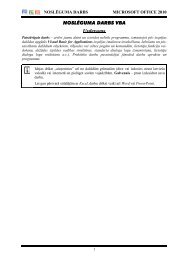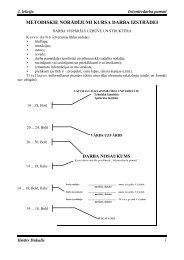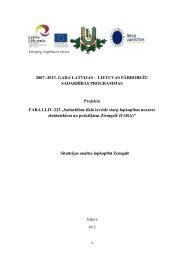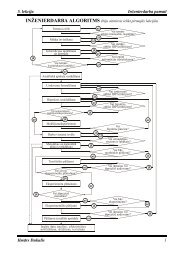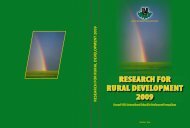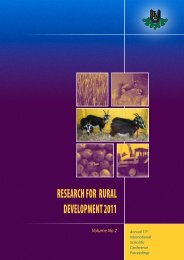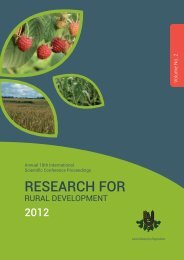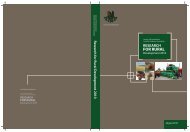Diāna Meiere, Antra Balode, Christina WedénPERSPECTIVES ON TRUFFLE CULTIVATION IN <strong>LATVIA</strong>similar climatic and physiogeographic characteristics,another edible truffle fungus is also known –Choiromyces venosus Vitt.Even truffle species within the Tuber genus maydiffer markedly in biology and ecology. Practicallythis is evident in the different cultivation techniquesrequired by the different species and in for exampletheir different harvest seasons, when the fruitbodiesripen and could be collected. Harvest season for thehighly prized T. melanosporum and also for the slightlyless prized T. brumale is restricted to the winter months,it starts from late November and finishes at the end ofMarch. Both species are commercially available fortruffle cultivation. In Latvia the ground starts to freezepermanently from the 20 th of November (Kalniņa,1995) and stays frozen at least until March 31 st , whichmakes maturing of the above mentioned speciesunlikely in the Latvian climate. During the last years,cultivation techniques have been developed also for awhite truffle T. borchii. Harvest season for this speciesstarts in January and ends in April, although findingsof fruitbodies has been reported from late summer tillautumn from several countries of Northern Europe,mentioned above.For four species of edible hypogeous fungi the mainmaturing season is within the time allowed by climaticconditions in Latvia: T. aestivum (September 15 th -January 15 th ), T. mesentericum Vitt. (September 15 th- January 15 th ), Tuber macrosporum Vitt. (Septemer1 st - December 31 st ) and Choiromyces venosus (July 1 st– September 30 th ) (Wedén, 2008). Among these, onlythe Burgundy truffle T. aestivum is cultivated on awider scale and cultivation techniques are well known.Adding the fact that the known natural distributionarea of T. aestivum is very close to Latvia and possiblefinds within the Baltic States are not unlikely, makesT. aestivum the most suitable truffle species for thefirst experiments with truffle cultivation in the BalticStates. The following assessment of suitable soiland climate regions in Latvia is therefore based onconditions necessary for T. aestivum.Therefore, the objective of this study was to justifythe choice of truffle species suitable for cultivationin Latvia, make a list of the most appropriate hosttree species, make assessment of soil and climateconditions in Latvia from the point of view of trufflecultivation and compose a map of areas favourablefor truffle cultivation in Latvia, using geological andclimate data.Materials and MethodsIn order to find the regions of Latvia most suitablefor the cultivation of the Burgundy truffle, soil andclimatic data were consulted. Maps used for theevaluation were: soil map of Latvia (Nikodemuset al., 2008), map of quaternary deposits of Latvia(Juškevičs and Krūmiņš, 1998), climatic map of Latvia(Pastors and Krūmiņš, 1998), maps with descriptionof the main soil regions of Latvia (Nikodemus et al.,2008; Āva, 1994), map of climate regions of Latviawith descriptions (Kalniņa, 1995). A map of potentialtruffle cultivation regions in Latvia was composedbased on the administrative regions of Latvia, addinggeological information and climate data. Soils inLatvia are very variable, and different soil types couldbe found within a small territory, so the proposedregions favourable for truffle cultivation are generalrecommendations, and detailed assessment shouldbe made on spot when choosing the site for truffleorchard establishment.Results and DiscussionTruffle species suitable for cultivation in LatviaThe Burgundy truffle has been chosen as the mostsuitable species for development of truffle cultivationin Latvia because of its fruiting season, wide naturaldistribution, including neighboring countries ofLatvia and thus also the probability of finding naturalpopulation of this species in Latvia. Preliminaryresults from molecular analyses indicate T. aestivummycorrhiza in root samples from a forest in Latvia(Meiere, unpublished data). There are several otherTuber species with high gastronomic value, for whichcultivation techniques presently are in different stagesof development. One of these is the most highlypriced truffle, the Alba truffle T. magnatum Pico,which previously has failed to produce in orchards.On a small scale, T. macrosporum, T. mesentericumand T. brumale are cultivated in Italy and France andare proposed for cultivation in Hungary (Vezzola,2008; Gogán, 2011). Of the mentioned species, onlyT. mesentericum has been found close to Latvia –in Sweden. Another edible hypogeous mushroomChoiromyces venosus has been found in Lithuania(Kataržytė, 2009) and Sweden. It has been suggestedas a potential species for cultivation experiments inSweden (Wedén, 2007). Until cultivation techniqueshave been developed and more insight is gainedinto the ecology and distribution patterns, it canhowever not be recommended for commercial trufflecultivation.Soils of LatviaSoils suitable for T. aestivum are well-drained,well-aerated, neutral or alkaline (pH KCl between7.1 and 8.0) (Chevalier and Frochot, 1997). Soiltexture could be variable, in natural T. aestivumhabitats on Gotland (Sweden) the range of claycontent is 10.4-32.6 g kg -1 , silt – 9.8-64.7 g kg -1 ,and sand – 12.9-79.8 g kg -1 (Wedén et al., 2009). Tofind the areas with the highest proportion of suitablesoils, several factors could be considered: soil type,soil texture as well as soil parent material. TheResearch for Rural Development 201273
PERSPECTIVES ON TRUFFLE CULTIVATION IN <strong>LATVIA</strong>Diāna Meiere, Antra Balode, Christina Wedénphysiography of Latvia and its neighboring areaswas formed, to a large degree, during the Quaternaryperiod and the Pleistocene ice age. The parent materialfor Latvian soil formation are the Quaternary deposits,among them glacial tills (moraines) are prevailing(Kārkliņš et al., 2009) and glaciolimnic deposits arethe main source of calcareous soils. The Nationalsoil classification system used in Latvia is not alwayseasily comparable to the international systems.According to the international soil classificationWRB (World Reference Base for soil resources),Latvian soils belong to Phaeozems and Stagnosols(Zemgale Plain), soils in uplands usually are Luvisols,Cambisols, Gleysols as well Histosols. In the forestssoils are Arenosols, Podzol, Umbrisols, Stagnosols,Albeluvisols and Cambisols (Nikodemus et al., 2008).In the national classification system there are severaltypes of soil with high content of carbonates, whichmeans that soils are neutral or slightly alkaline andare favorable for the truffle development. Such soils(Sod calcareous soils in national classification system)cover approximately 5.5–6.0% of the total area ofagricultural land; in several parts of Latvia (central partof Latvia in vicinity of Jelgava, Bauska, Dobele and toa lesser extent – around Tukums) they comprise about50% of the total area of agricultural land (Kārkliņš etal., 2009). There are smaller territories of such soils inRietumkursas Upland (western part of Latvia) as wellas in other parts of Latvia where limnoglacial depositsare found. In the vicinity of Kandava and Sigulda, veryshallow carbonatic soils of Rendzina type are found.Climate in Latvia and its suitability for the trufflecultivationEvaluation of the climatic characteristics is veryimportant in finding the most favorable areas for thetruffle cultivation in Latvia. It is believed that theclimate is the most important limiting factor for thedevelopment of T. aestivum cultivation in Europe,especially in the northern countries (Chevalier, 2010).A long and mild autumn is crucial for the propermaturation of T. aestivum fruitbodies throughout theharvest season. If the soil freezes early, the truffleharvest also ends for that season.The Latvian climate is humid Europeancontinental with the maritime influence of the BalticSea. Summers are warm, and the weather is mild inspring and autumn, however, winters could be fairlycold. The mean temperature of the year is 4.3–6.6 °C.Precipitation is distributed throughout the year withthe heaviest rainfall in July. Annual precipitationranges from 500 to 837 mm with the maximumrainfall during the summer and autumn months(70% from April till October), which is favorablefor the development of most truffle species (Table1). The mean daily temperature in January is from-2.6 °C (coastal areas of the Baltic Sea) to -7.5 °C(more continental parts of the country); in July from+16.5 °C to +17.6 °C which is equivalent or even a bithigher than for T. aestivum and T. borchii producingareas in Sweden, Denmark and the United Kingdom(Hall et al., 2007). Accumulated degree days show thelength of the vegetation period for plants, and sincetruffles are closely connected with their host plants,good conditions for the host trees might also meangood development of truffles. Despite that Latvia isa northern country, the number of annual sunshinehours is relatively high. As seen in the summary ofthe climatic data given in Table 1, the only parameterwhich differs significantly between Latvia and edibletruffle-producing areas is a comparatively low meanair temperature in January. It could be a limiting factorfor the development of truffle species with a moresouthern distribution, but a stable snow cover mightalso reduce the impact of the cold.Suitable host tree speciesTruffles are mycorrhiza-forming fungi, and growin a symbiotic association with, usually arboreal,plant. Most truffle species can form symbiosis andgrow with several tree species, although some ofthem are considered better host trees than others. Forthe cultivation purposes, choosing tree seeds fromspecies well adapted to the local climate is important.Comparison of climatic data of edible truffle Tuber spp. – producing areas and LatviaTable 1Truffle speciesAnnualprecipitation(mm)Mean dailytemperature insummer, July(°C)Mean dailytemperature inwinter, January(°C)Accumulateddegree days(>10 °C)AnnualsunshinehoursTuber melanosporum 1 563-1443 19.2-24.6 1.6-9.2 1115-2341 1704-2837T. magnatum 1 589-1545 21.3-24.6 2.4-5.0 1349-2009 1989-2388T. aestivum 1 514-1045 15.2-26.2 –1.1-12.5 489-2009 1375-2837T. borchii 1 514-1045 15.2-26.2 0.1-12.5 489-3125 1375-2388Latvia 2 500-837 16.5-17.6 –7.5- –2.6 1700-2100 1680-19001Data from Hall et al., 20072Data from Kalniņa, 199574 Research for Rural Development 2012



